Guide to Heart Rate Variability (HRV) for Triathletes
 Karen Parnell
December 23, 2021
Karen Parnell
December 23, 2021
Guide to Heart Rate Variability (HRV) for Triathletes
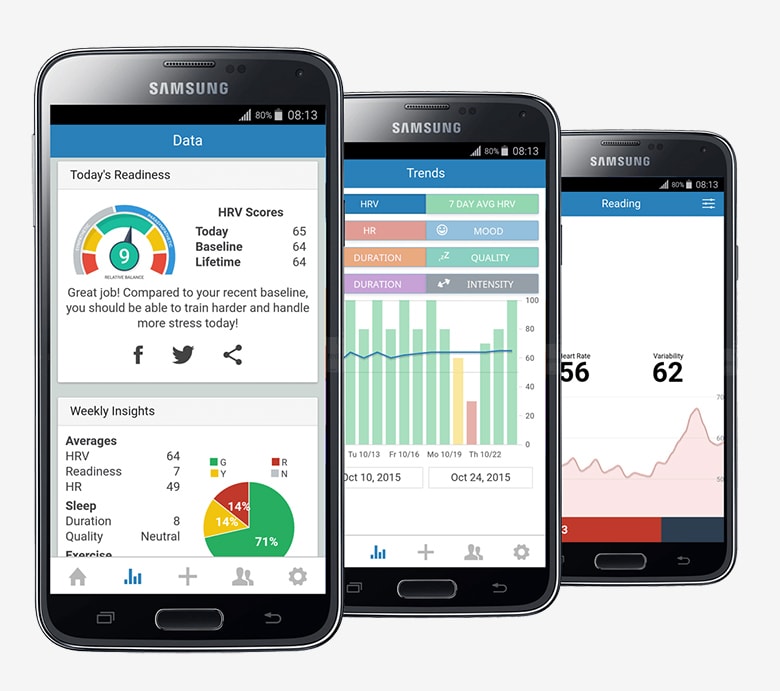
Elite HRV App Screen Shots
Heart Rate Variability or HRV has been gaining popularity amongst athletes and triathletes and there are many reasons to consider using these readings to help with your training. This blog discusses what it is and why you may find it useful.
What is Heart Rate Variability (HRV)?
Heart Rate Variability (HRV) is an accurate, non-invasive measure of your Autonomic Nervous System (ANS) – which responds to everything: how you exercise, recover, eat, sleep and perceive stress. Unlike basic heart rate (HR) that counts the number of heart beats per minute, HRV looks much closer at the exact changes in time between successive heartbeats (also called inter-beat intervals, RR intervals, NN intervals, etc).
The Autonomic Nervous System is a component of the peripheral nervous system that regulates involuntary physiologic processes including heart rate, blood pressure, respiration, digestion, and sexual arousal. It contains three anatomically distinct divisions: sympathetic, parasympathetic, and enteric. For HRV we will consider the sympathetic and parasympathetic systems.
Your “fight or flight” response is an automatic physiological reaction to an event that is perceived as stressful or frightening. The perception of threat activates the sympathetic nervous system (SNS) and triggers an acute stress response that prepares the body to fight or flee.
Your parasympathetic nervous system (PNS) is also referred to as the 'rest and digest' system as it functions to conserves the body's natural activity and relaxes the individual once an emergency has passed. The parasympathetic nervous system leads to decreased arousal.
To some extent HRV is counter intuitive as the inter beat times become more stable as your fight or flight mechanism kicks in. Hormones such as Adrenaline, Cortisol, Norepinephrine kick in, and your body gets ready to run or fight. This can be caused by the stress of being late for a meeting, getting married, your children getting poor grades, over training and many other factors.
It's good idea to record things that could cause your stress (mental and physical) and try to reduce or avoid them. When your stress levels are low the inter-beat intervals become shorter and longer - irregular so when this happens you can train harder that day.
Get some FREE resources including training plans here.
How to Measure HRV
Elite HRV - Heart Rate Variability
I use a free App called Elite HRV every morning to understand my Heat Rate Variability (HRV) which relates to your physical and mental stress levels. You will need a Bluetooth heart rate monitor to do this and a list of tested and recommended HRMs are listed in the App. I use a low cost HRM from Amazon and it’s detailed later. When you wake up you simple attached your heart rate monitor, open the App and take a reading for a few minutes. The App will then interpret the reading for you and give you a recommendation on how hard to train that day and how stressed you may be.
I use this along with how I feel to work out if I should train hard or easy that day or even have a rest day with guided meditation. I would not use this solely as my guide to training but with the help of the diary in the App you can start to understand your work, life and training stress triggers and think about reducing these stress inducers.
Below are some screen shots from the App to show you what data you will get:
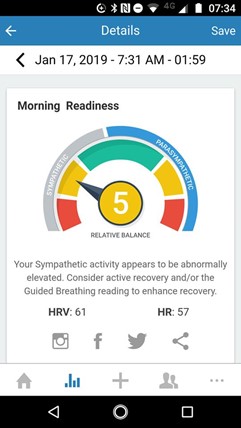
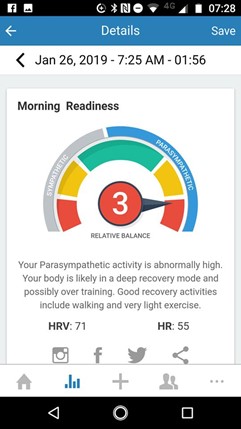
The Elite HRV App showing your morning readiness score
In the App you get a score of between 1 and 10 for Sympathetic and Parasympathetic readings. You can see that the App will tell you what your reading means for example if your Sympathetic activity is elevated it may suggest active recovery and guided breathing. If your Parasympathetic activity is high, it may suggest recovery activities such as walking or light exercise.
On another day your morning readiness score may show a higher number like a 9 shown in the image below and it says you can train harder today.
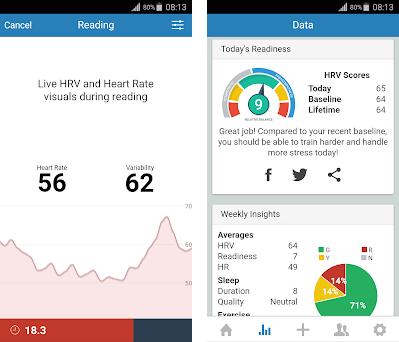
The Elite HRV App showing live HRV and Heart rate and a screen showing your morning readiness score and what it means
These scores should not be used in isolation but used in conjunction with how you feel to make a decision about how hard you should train that day.
Heart Rate Monitors
You don’t need an expensive heart rate monitor to take the readings, for example I use the one below from Amazon. The heart rate monitor just needs Bluetooth to connect to the App.
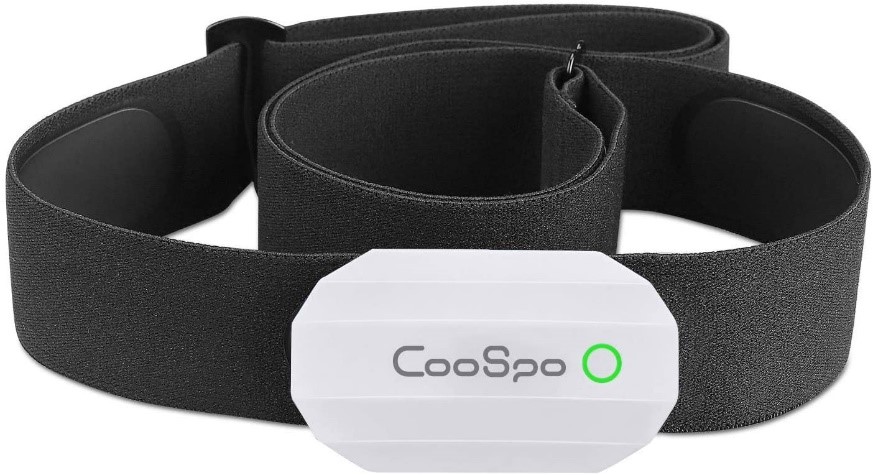
CooSpo Heart Rate Monitor ANT + Bluetooth 4.0 Waterproof Sensor with Chest Strap on Amazon.co.uk £23.99
Your heartrate monitor (HRM) should be an electrical or electrocardiography (ECG) type to use it with the Elite HRV App, which is usually in the form of a heart rate monitor strap. The optical or photoplethysmography (PPG) ones like the ones built into your sports watch or arm strap HRM cannot measure the inter-beat durations needed by the HRV App. You can tell an optical HRM from the green light it emits.
Measuring HRV on your Garmin Watch
You can now measure your HRV on Garmin watches.
In the past, Garmin detected the HRV values through the heart rate band, but users had to face the discomfort of the heart rate band. Now, you can download the app through the Garmin Connect IQ store, and can use the wrist optical heart rate to carry out HRV measurement.
This is an extrapolated mathematical HRV reading based on an optical heart rate sensor so some argue this is not as accurate as a chest heart rate monitor strap which is an ECG type sensor.
But using your Garmin watch can be more convenient and should give you an indication of your HRV score.
This method of recording and analysing HRV is via the Garmin HRV App.
You can read more about it the Garmin HRV App here.
A list of the Garmin watches that support HRV are listed here.
HRV Recording using Polar and Apple Watches
Both Polar and Apple watches record heart rate data and use this data to calculate your HRV.
On the Polar devices they call their data "Nightly Recharge" which is not truly HRV but is a useful score to appreciate. Nightly Recharge™ is an overnight recovery measurement that shows how well your body has coped with overall stress you have experienced lately. You can read more about it on the Polar website and if you think this will be useful for you.
Apple supports HRV reading and analysis in it's Apple Health App and is reported to be an accurate way to record understand your HRV score.
The Apple Health App does not give a specific HRV reading right now so using a 3rd party App like Training Today will help you make sense of the data. After allowing it to read your HRV data from the Health app, the app compares your current HRV to your baseline to make a recommendation like taking time for recovery, “keep steady but listen to your body,” or “ready for peak performance.”
Training Today calls it a readiness to train (RTT) score and works on an easy-to-use, color-coded 0-10 scale.
You can read about how to use the Apple Watch and HRV App here.
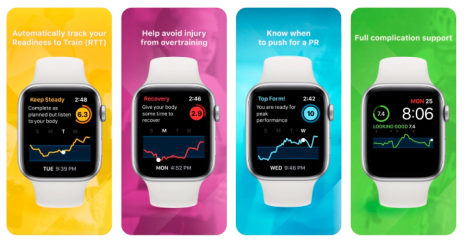
Apple Watch Training Today HRV App advise screens and colour coding
HRV Assessment on the Coros Pace 3 Watch
Coros watches now support HRV assessment on their PACE 2, PACE 3, APEX Pro 1, APEX 2, APEX 2 Pro, VERTIX 1, VERTIX 2 watches. I have the Coros Pace 3 and it's now the watch I use for training, read why here.
Your COROS watch will automatically measure heart rate variability, or HRV, anytime you wear your watch to sleep. Measuring your HRV overnight is an easy, non-invasive way to monitor your body's autonomic nervous system's response to stress. This stress measurement provides you with insight into your body's physical and mental response to both daily, and overnight factors such as life and work stress, training, and sleep quality.
To receive your HRV Assessment, wear your watch to sleep for 5 nights to establish a baseline. Once you have done so, you'll be able to see your assessment on your watch or in the COROS app.
To view your HRV Assessment in the COROS app, navigate to your Progress page, then select HRV Assessment.
Your HRV is measured continuously overnight in 10-minute intervals to provide you with an average HRV score.
Your Normal Range is established from previous nights HRV data, to provide you with a baseline assessment of where your HRV typically is. When your HRV readings are within your Normal Range, this means that your body is responding to stress in a typical manner. Elevated HRV may indicate less stress, while lower HRV typically points to higher stress levels.
Toggle between Day, Week, and Month to view your HRV trends over time.
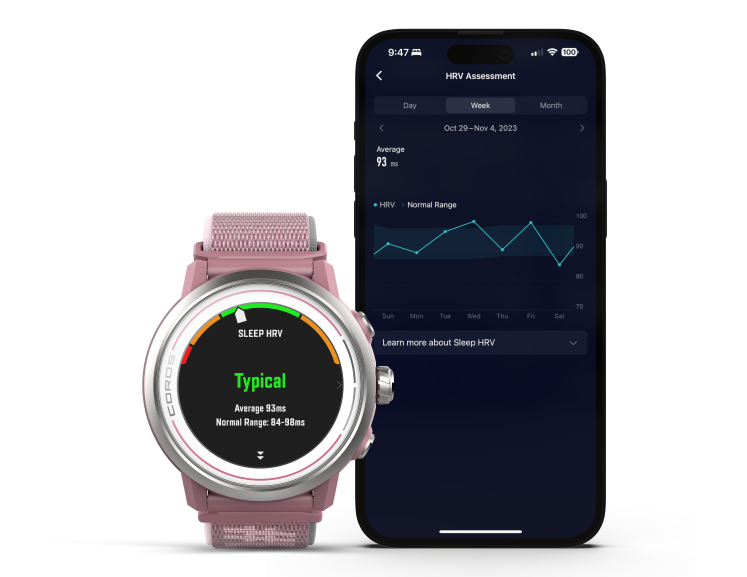
Coros Watches support HRV Assessment
How to Interpret HRV
After taking you morning readiness score for about 10 days you will have a baseline score to work from but what do you do with your results?
A healthy, resilient athlete will have a high, relatively unvarying HRV combined with a stable, low resting heart rate (RHR). An unhealthy athlete showing signs of sickness, overtraining or is injury-prone athlete will have lower, volatile HRV readings. Matti Rowe put together a great graphic below showing what this looks like.
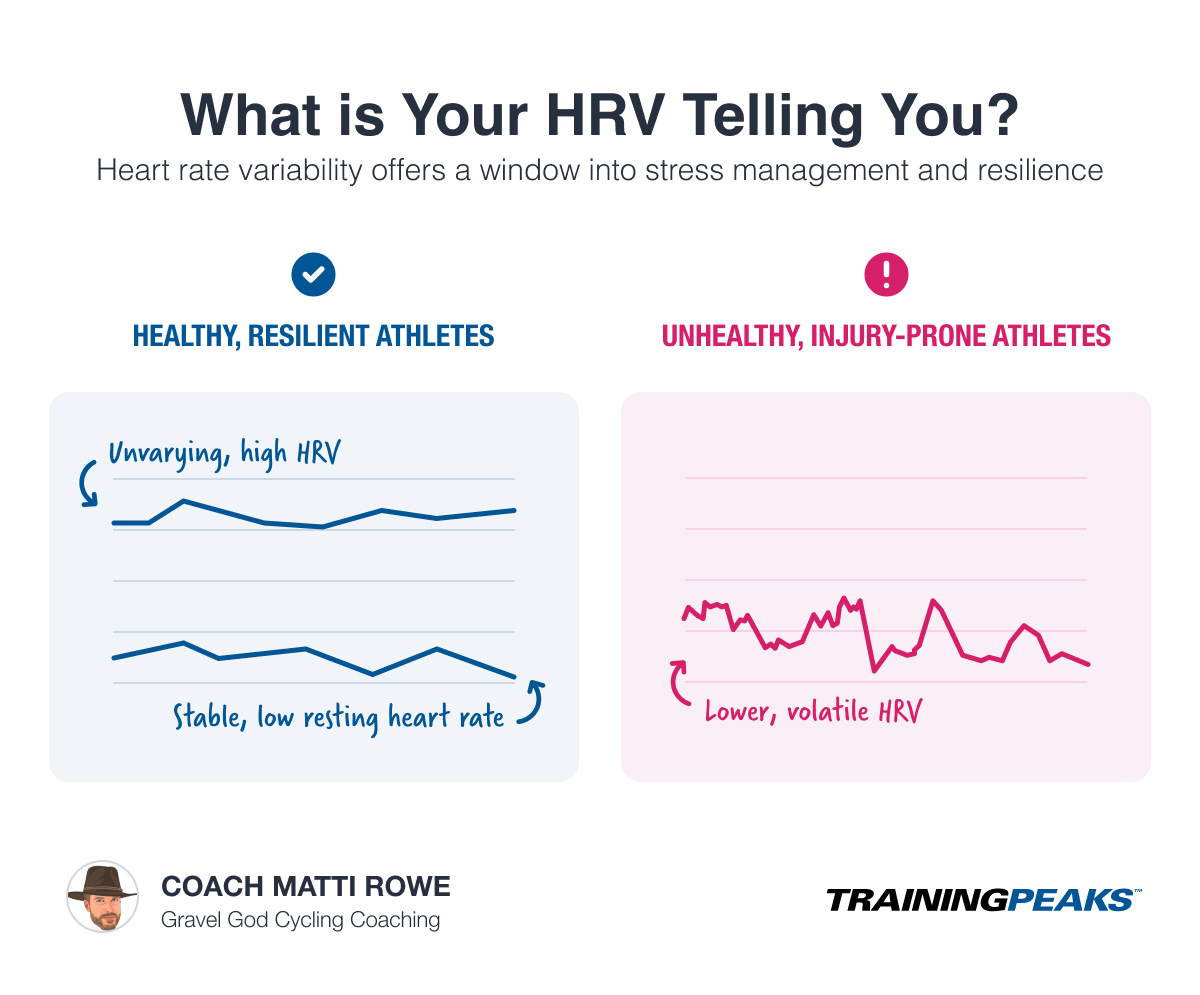
Healthy, resilient athlete versus Unhealthy, injury prone athlete HRV score source: Trainingpeaks
Now you have a bit more of a view on what looks “good” and what looks “bad” when it comes to HRV it’s worth bearing a few things in mind.
HRV does not predict your performance but is instead a figure of your fatigue level. You can regularly perform well even when fatigued (e.g., if you wake up with a low HRV reading) but remember that for adaptation to occur to make sure your training is effective, you must take time to recover.
If HRV remains within a normal range after you complete a hard workout, it’s a great sign! A stable HRV demonstrates that your nervous system could absorb the stimulus.
HRV reflects the nervous system, so it won’t necessarily correlate with other training stressors, like delayed onset muscle soreness (DOMS).
Once you start to understand your scores you will probably start looking into how you compare with other athletes. This can however cause confusion as you are unique, and your work and life situation are unique so it’s probably best to record your life stress alongside your training stress and relate it to your personal HRV and try to understand what affects your stress levels.
Factors that affect your HRV include life, sleep, nutrition, and alcohol consumption. Let’s look at these in turn.
Life Stress
As an age group athlete or triathlete, you probably don’t get paid to train and compete. You will be trying to balance work, family, friends, and other responsibilities with your free time to train, race, socialize, resting/recovering and other hobbies. You will probably spend 80% of your time concentrating on work and home life and 20% on your free time activities.
Keeping a diary of all of this is a good idea to see what is causing the most stress in your life. You can look at either managing your stress level, avoiding similar situations, or finding your own coping mechanisms like meditation, massage or working with your coach to balance your training load with your “life load”.
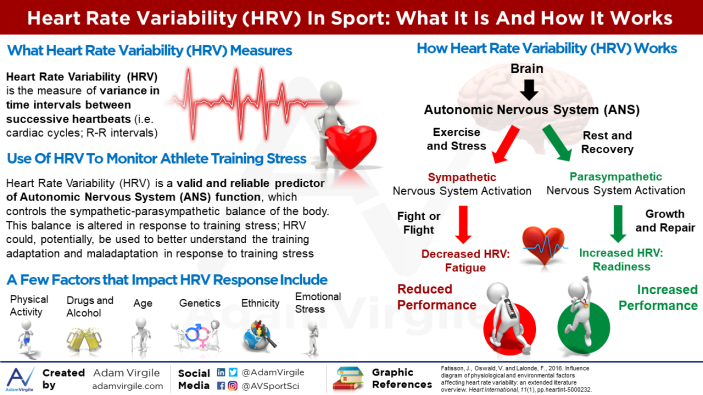
HRV for athletes how it works and the factors that impact HRV Source: adamvirgile.com
Nutrition
Optimising your diet to ensure your train and recover well is a core part of training well to meet your race goals. Extreme changes in diet will show in your HRV score. Say for example you decide to dramatically reduce your carbohydrate intake to lose some weight before race day this will have an adverse effect on your HRV. This will be especially apparent if you restrict your diet in a build phase and your body will understandably rebel against this and you will not see the gains you are aiming for.
It's good to experiment with nutrition in your training but maybe consider doing this early in your season where your training load is lower.
Alcohol
No surprises but alcohol negatively affects your recovery and performance. Next time you go out and enjoy some alcohol take a look at your HRV and you will see what happens. You will see your HRV score go down and resting heart rate increase.
You may think that training will balance out the glasses of red wine your drink – reward for taking care of yourself – but in reality, you will never do this.
Your body drops everything to process the alcohol and flush it out of your system before it resumes any other tasks, like replenishing your glycogen stores or repairing all the muscular and metabolic damage you created during your five-hour training day. In other words, drinking isn’t cancelled out by the stress of your training; it adds to the stress of your training.
If you tend to drink a lot to “de-stress” after a hard day at work, you will always be compromising your athletic potential. But this is a choice based on your goals and what you enjoy in life.
To cut down or try life without alcohol you could try a “Sober in October” challenge – maybe even get sponsored for your favourite charity?
Or you could try alcohol free beer and wine which is getting more like the taste of its alcohol laden alternative. You can red more about alcohol free beer and athletes here.
But as mentioned the choice is yours and your HRV score will remind you how alcohol affects your body and training.

Photo by Jon Parry on Unsplash
Sleep
As you know poor sleep will always limit your potential, but it can especially hinder your progression in the build period. Sleep is the most important driver of recovery. If you hold back on sleep, you are inadvertently agreeing to compromise your ability to adapt to your training.
HRV software does track your sleep and whilst it may not be 100% accurate it will show a trend and relationship to your HRV and training performance.
If you find yourself always feeling fatigued even when you are not training hard it’s worth looking at your sleep patterns. Here are some tips on how you could improve your sleep quality and time.

Photo by Kate Stone Matheson on Unsplash
Conclusion - The Benefits of HRV for your Training
By considering your HRV daily score you can have a better idea if you are highly stressed or tending towards over training. Over training can lead to injuries or sickness, less motivation, poor concentration, loss of appetite, lowered immune system and inability to progress athletically.
Measuring your HRV after a race can help you decide if you are fully recovered and can start back to full training.
Using the HRV App diary you can also see a pattern and identify stress triggers which you can learn to manage or avoid. These stressors could be work, training, home situations and more.
The key to a good performance on race day may not just be a case of training consistently but also balancing all of your life stressors, eating well, sleeping well and cutting down on alcohol.
HRV may be a good reading to add into the mix so that you train well and meet your race goals.
Get some FREE resources including training plans here.
Would you like a free training plan? Claim your free plan or e-book.
Karen Parnell is a Level 3 British Triathlon and IRONMAN Certified Coach, 8020 Endurance Certified Coach, WOWSA Level 3 open water swimming coach and NASM Personal Trainer and Sports Technology Writer.
Karen has a post graduate MSc in Sports Performance Coaching from the University of Stirling.
Need a training plan? I have plans on TrainingPeaks and FinalSurge:
I also coach a very small number of athletes one to one for all triathlon and multi-sport distances, open water swimming events and running races, email me for details and availability. Karen.parnell@chilitri.com
Get your FREE Guide to Running Speed and Technique
Get your FREE Swim Workouts for Triathletes E-book
Get your FREE Open Water Swimming Sessions E-Book
FAQ: Heart Rate Variability (HRV)
What is heart rate variability (HRV)?
Heart rate variability (HRV) is the measure of the variation in time between consecutive heartbeats. It is a useful indicator of the autonomic nervous system's activity, which controls many of the body's involuntary functions, such as breathing, digestion, and heart rate.
Why is HRV important?
HRV is an important indicator of overall health and wellbeing. A higher HRV is generally associated with better health outcomes, such as improved cardiovascular health, reduced stress levels, and better mental health. Conversely, a lower HRV is associated with increased risk of cardiovascular disease, diabetes, and other health problems.
How is HRV measured?
HRV can be measured using various techniques, including electrocardiography (ECG), photoplethysmography (PPG), and accelerometer-based devices like the CooSpo Heart Rate Monitor (HRM). ECG is the most accurate and widely used method for HRV measurement. It involves attaching electrodes to the skin to record the electrical activity of the heart. PPG measures changes in blood volume by shining a light through the skin, while accelerometer-based devices measure the acceleration of the body during movement.
What are some common ways to record HRV?
There are several ways to record HRV, including:
- Wearable devices: There are many wearable devices available that can measure HRV, including smartwatches, fitness trackers, and chest straps.
- Smartphone apps: There are several smartphone apps available that can measure HRV using the phone's camera or sensors.
- ECG monitors: ECG monitors are medical devices that can be used to record HRV. They are typically used in clinical settings or by healthcare professionals.
- Laboratory tests: HRV can also be measured in a laboratory setting using specialized equipment, such as an ECG machine.
How often should I record my HRV?
The frequency of HRV recording depends on your goals and objectives. If you are tracking your HRV for general health and wellbeing, recording it once or twice a week is sufficient. If you are using HRV to monitor a health condition or to optimize your athletic performance, you may need to record it more frequently, such as daily or even several times a day.
How can I improve my HRV?
There are several lifestyle factors that can improve HRV, including getting regular exercise, reducing stress, getting enough sleep, and maintaining a healthy diet. Certain breathing exercises, such as deep breathing and meditation, can also improve HRV.
What are Garmin, Apple, and Polar watches?
Garmin, Apple, and Polar watches are wearable devices that provide various health and fitness tracking features, including heart rate monitoring, sleep tracking, and activity tracking. These devices are popular among athletes and fitness enthusiasts.
What is HRV monitoring on these watches?
HRV monitoring on these watches involves measuring the variation in time between consecutive heartbeats. This information is used to provide insights into the user's autonomic nervous system activity, which can be used to monitor stress levels, recovery, and overall health.
How do these watches measure HRV?
These watches use various methods to measure HRV, including optical heart rate sensors, accelerometers, and chest straps. Optical heart rate sensors are the most common method and work by shining a light through the skin to measure changes in blood volume.
Are these HRV measurements accurate?
The accuracy of HRV measurements on these watches can vary, depending on the device and the method used. Optical heart rate sensors can be affected by factors such as skin colour, motion, and ambient light. Chest straps are generally considered to be more accurate than optical sensors, but they can be uncomfortable to wear during exercise.
Can HRV measurements on these watches be used to diagnose medical conditions?
HRV measurements on these watches are not intended for medical diagnosis or treatment. However, they can provide useful information about overall health and wellbeing.
How can HRV measurements on these watches be used to improve health and fitness?
HRV measurements on these watches can be used to monitor stress levels, recovery, and overall health. By tracking HRV over time, users can identify patterns and make lifestyle changes to improve their health and fitness. For example, if a user notices that their HRV is consistently low, they may need to adjust their training program, get more rest, or reduce stress levels.
Which watch is the best for HRV monitoring?
The best watch for HRV monitoring depends on the user's needs and preferences. Garmin, Apple, and Polar watches all offer HRV monitoring features, but they differ in terms of accuracy, battery life, and other features. Users should research and compare different models before making a decision.
Can HRV measurements on these watches replace medical advice or treatment?
No, HRV measurements on these watches are not intended to replace medical advice or treatment. Users should consult a healthcare professional if they have any concerns about their health.
References
(PDF) Accuracy of the Garmin 920 XT HRM to perform HRV analysis (researchgate.net)
Altini, M. (2018, October 12). Heart Rate Variability (HRV) features: can we use SDNN instead of rMSSD? A data-driven perspective on short term variability analysis. Heart Rate Variability (HRV) features: can we use SDNN instead of rMSSD? A data-driven perspective on short term variability analysis (hrv4training.com)
Centers for Disease Control and Prevention. (2022, April 19). Dietary Guidelines for Alcohol. Retrieved from Facts about moderate drinking | CDC
Lezama, S. (2022, March 11). What is Heart Rate Variability? The Definitive Guide to HRV. Retrieved from What is Heart Rate Variability? - Elite HRV
Shuval, K. et al. (2022, January 1). Fit and Tipsy? The Interrelationship between Cardiorespiratory Fitness and Alcohol Consumption and Dependence. Retrieved from Fit and Tipsy? The Interrelationship between Cardiorespiratory Fitness and Alcohol Consumption and Dependence - PubMed (nih.gov)
Van Deusen, M. (2021, August 11). Everything You Need to Know About Heart Rate Variability (HRV). Retrieved from What is Heart Rate Variability (HRV)? [The Ultimate HRV Guide] (whoop.com)
Heart Rate Variability (HRV) in Sport: A Review of the Research - Adam Virgile Sports Science
How to Interpret HRV to Reduce Stress and Increase Performance (trainingpeaks.com)
